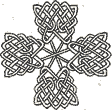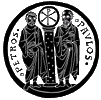
A group of spear carriers dressed in animal skins and with painted bodies had been silently following the monks. They were amazed at the power that could quell the monster that had terrified them for so long. These men were Picts. The monk was on his way to visit their King Brude. The swift stream was the River Ness, and the incident took place near what is now called Inverness. The monk was named Colum Kil, meaning "dove of the church," who is now known as Saint Columba. The monster story is an old one, but even today some people believe that there is such a monster living in Loch Ness.
The news of Saint Columba's arrival quickly reached King Brude, who retired to his fortress and locked the gates. When Columba reached the barred gates, he again made the sign of the cross. The gates flew open and he walked in with his followers.
Thereupon the king came out of his house with his warriors and druids (Pictish priests). The druids hated Columba because if the king became a Christian, they would no longer be important. It is sometimes said that Brude became a Christian that very day, but it did not happen that way. The king listened to what Columba had to say and agreed that he could go anywhere he liked in the kingdom of the Picts to preach. The druids didn't like the decision, but in the end both they and their king became Christians.
Saint Columba was born in Gartan, County Donegal, Ireland, in 521. Before his birth an angel had assured his mother that she would bear a son of great beauty who would be remembered among the Lord's prophets. Saint Buite, the dying abbot of Montervoice in County Louth, is said to have foretold the birth of a child illustrious before God and men.
Columba was of royal blood. His father Phelim was of the Uí Néill clan and descended from the famous Niall of the Nine Hostages, while his mother Eithne was descended from a king of Leinster. As was customary in ruling families, Columba was fostered, but what was unusual about his fostering was that he was put in the care of a priest.
He went on to study under Saint Finnian of Moville, County Down, and is reputed through his intercessions to have worked miracles. Later he became a pupil of Saint Finnian of Clonard and was destined to become the most famous of the latter's "twelve apostles of Ireland."
Saint Columba eventually founded monasteries himself. His first was at Derry in 548. Another was at Durrow, County Offaly, which became famous for its hand-written, beautifully illuminated manuscripts. In 563 he sailed with twelve followers to found a monastery on the Scottish island of Iona, which was part of the Scottish kingdom of Dalriada, ruled by his cousin Conaill.
Saint Columba was actually exiled to Iona after having been banished from Ireland. His exile was punishment for having instigated a war. It seems that when Saint Columba visited Moville, he saw a magnificently illuminated manuscript of a Psalter belonging to Saint Finnian. He set about secretly copying it, but Saint Finnian found out what he was doing and demanded that he hand over the copy. When Columba refused, the matter was referred to King Diarmuid, who ruled in Finnian's favor.
Saint Columba already resented Diarmuid for slaying a youth to whom the saint had given sanctuary. He therefore returned to his own kinsmen and urged them to wage war against Diarmuid. Hundreds of men were killed before Diarmuid was defeated at Cuildreimhne, County Sligo.
After the battle, Columba got back his copy of Saint Finnian's book, but it was small consolation. He was blamed for the hundreds of deaths in the war he had instigated. The synod of bishops told him he had broken his monastic rule. He was supposed to be humble and obedient and a man of peace, whereas he had been proud, disobedient, and warlike, and they wanted to excommunicate him.
Fortunately for Columba, Saint Brendan saw that he was truly sorry for his sins, and he asked the other members of the synod to give Columba a new chance. In the end they agreed but said Columba was banished from Ireland forever. It was at this point that with twelve followers he founded a monastery on Iona. He grew to love the island and called it "Iona of my heart."
Visitors often came to Iona. Some were religious pilgrims and some were important people seeking political advice. In humility Columba would wash their feet as our Lord had done for the Apostles at the Last Supper.
The monastery on Iona had a profound influence on the Celtic Church as a whole, and on the spread of Christianity in Scotland and northern England. Columba and other missionaries walked throughout Scotland at a time when it was a wild and dangerous country. They were often in danger of being attacked or killed, but they continued anyhow.
Columba was also a political figure of consequence. His early conversion of Brude, king of the Picts, reduced the threat of attacks on Christian Dalriada. In 575, when he was returning to Ulster for a meeting held at Drum Ceatt, he negotiated the Scottish kingdom's independence from the Irish Dalriada. Columba is therefore regarded as one of the founders of the independent kingdom of Scotland.
When Saint Columba was too old and weak to walk about, the monks made him a little chariot so that he could visit them as they worked in the fields.
One day in the spring of 597 he told his faithful servant, Diormit, that at midnight he would leave them, but that the servant should tell no one. He attended the evening service as usual. At midnight he rose from his bed and went to the church. As Diormit and the monks rushed in, he raised his hand in a final blessing before he reposed.
In the following century a chronicle of his life by Saint Adomnán attributed to him many prophecies, visions, and miracles, not the least of which was warding off the Loch Ness monster with the sign of the cross.
References:
Ross, David. The Story of Saint Columba. New Lanmark, Scotland: Waverley Books Ltd., 1998.
Wallace, Martin. Celtic Saints. San Francisco: Chronicle Books, 1995.
Saint Finnian of Clonard

Saint Finnian became convinced that the ascetic life offered the best way of consecrating one's life to God. It was a belief well suited to Ireland, with its population dispersed in small rural kingdoms. Finnian's first monastery was at Aghowle, County Wicklow, but he settled c. 520 at Clonard, County Meath, on the River Boyne. Clonard became the most famous monastic school of the sixth century, its importance derived from the number of disciples who left to found other monasteries. Finnian's most prominent pupils have been called the twelve apostles of Ireland. The Saint died of the plague c. 549, but the monastery at Clonard survived until the sixteenth century.
Saints Columba and Finnian, intercede for us!
Adapted from Celtic Saints, by Martin Wallace (San Francisco: Chronicle Books, 1995), pp. 13–15.
